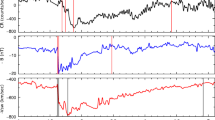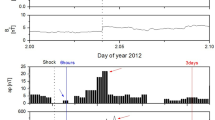Abstract
Earth’s bow shock is the result of interaction between the supersonic solar wind and Earth’s magnetopause. However, data limitations mean the model of the shape and position of the bow shock are based largely on near-Earth satellite data. The model of the bow shock in the distant magnetotail and other factors that affect the bow shock, such as the interplanetary magnetic field (IMF) B y , remain unclear. Here, based on the bow shock crossings of ARTEMIS from January 2011 to January 2015, new coefficients of the tail-flaring angle α of the Chao model (one of the most accurate models currently available) were obtained by fitting data from the middle-distance magnetotail (near-lunar orbit, geocentric distance -20R E>X>-50R E). In addition, the effects of the IMF B y on the flaring angle α were analyzed. Our results showed that: (1) the new fitting coefficients of the Chao model in the middle-distance magnetotail are more consistent with the observed results; (2) the tail-flaring angle α of the bow shock increases as the absolute value of the IMF B y increases. Moreover, positive IMF B y has a greater effect than negative IMF B y on flaring angle. These results provide a reference for bow shock modeling that includes the IMF B y .
Similar content being viewed by others
References
Bennett L, Kivelson M G, Khurana K K. 1997. A model of the Earth’s distant bow shock. J Geophys Res, 102: 26927–26942
Binsack J H, Vasyliunas V M. 1968. Simultaneous IMP 2 and OGO 1 observations of bow shock compression. J Geophys Res, 73: 429
Chao J K, Wu D J, Lin C H, Yang Y H. 2002. Models for the size and shape of the Earth’s magnetopause and bow shock. Cospar Colloq Ser, 12: 127–135
Chapman J F, Cairns I H. 2003. Three-dimensional modeling of Earth’s bow shock: Shock shape as a function of Alfvén Mach number. J Geophys Res, 108: A5, doi: 10.1029/2002JA009569
Chapman J F, Cairns I H, Lyon J G, Boshuizen C R. 2004. MHD simulations of Earth’s bow shock: Interplanetary magnetic field orientation effects on shape and position. J Geophys Res, 109: A4, doi: 10.1029/2003JA010235
Dmitriev A V, Chao J K, Wu D J. 2003. Comparative study of bow shock models using Wind and Geotail observations. J Geophys Res, 108: A12, doi: 10.1029/2003JA010027
Fairfleld D H. 1971. Average and unusual locations of the Earth’s magnetopause and bow shock. J Geophys Res, 76: 6700
Farris M H, Petrinec S M, Russell C T. 1991. The thickness of the magnetosheath—Constraints on the polytropic index. Geophys Res Lett, 8: 1821–1824
Farris M H, Russell C T. 1994. Determining the standoff distance of the bow shock: Mach number dependence and use of models. J Geophys Res, 99: 17681–17689
Formisano V. 1979. Orientation and shape of the Earth’s bow shock in three dimensions. Planet Space Sci, 27: 1151–1161
Hu H P, Lu J Y, Zhou Q, Wang M, Yang Y F, Liu Z Q, Pei S X. 2015. Simulation of three-dimensional Earth’s bow shock (in Chinese). Chin J Space Sci, 35: 1–8, doi: 10.11728/cjss2015.01.001
Hu Y Q, Peng Z, Wang C. 2010. Rotational asymmetry of Earth’s bow shock (in Chinese). Chin J Geophys, 53: 773–781
Kellogg P J. 1962. Flow of plasma around the Earth. J Geophys Res, 67: 3805–3811
Liu Z Q, Lu J Y, Kabin K, Yang Y F, Zhao M X, Cao X. 2012. Dipole tilt control of the magnetopause for southward IMF from global magnetohydrodynamic simulations. J Geophys Res, 117: A7, doi: 10.1029/2011JA017441
Lu J Y, Liu Z Q, Kabin K, Jing H, Zhao M X, Wang Y. 2013. The IMF dependence of the magnetopause from global MHD simulations. J Geophys Res, 118: 3113–3125
Merka J, Szabo A, Narock T W, King J H, Paularena K I, Richardson J D. 2003. A comparison of IMP 8 observed bow shock positions with model predictions. J Geophys Res, 108: A2, doi: 10.1029/2002JA009384
Merka J, Szabo A, Narock T W, Richardson J D, King J H. 2005a. Three decades of bow shock observations by IMP 8 and model predictions. Planet Space Sci, 53: 79–84
Merka J, Szabo A, Slavin J A, Peredo M. 2005b. Three-dimensional position and shape of the bow shock and their variation with upstream Mach numbers and interplanetary magnetic field orientation. J Geophys Res, 110: A4, doi: 10.1029/2004JA010944
Ness N F. 1966. Earth’s magnetic field: A new look. Science, 151: 1041–1052
Parker E N. 1963. Interplanetary Dynamical Process. New York: Interscience
Peredo M, Slavin J A, Mazur E, Curtis S A. 1995. Three-dimensional position and shape of the bow shock and their variation with Alfvenic, sonic and magnetosonic Mach numbers and interplanetary magnetic field orientation. J Geophys Res, 100: 7907–7916
Shi Q Q, Zong Q G, Zhang H, Pu Z Y, Fu S Y, Xie L, Chen Y, Li L, Xia L D, Liu Z X, Fazakerley A H, Reme H, Lucek E. 2009. Cluster observations of the entry layer equatorward of the cusp under northward interplanetary magnetic field. J Geophys Res, 114: A12219, doi: 10.1029/2009JA014475
Shi Q Q, Zong Q G, Fu S Y, Dunlop M W, Pu Z Y, Parks G K, Wei Y, Li W H, Zhang H, Nowada M, Wang Y B, Sun W J, Xiao T, Reme H, Carr C, Fazakerley A H, Lucek E. 2013. Solar wind entry into the highlatitude terrestrial magnetosphere during geomagnetically quiet times. Nat Commun, 4, doi: 10.1038/ncomms2476
Shi Q Q, Hartinger M D, Angelopoulos V, Tian A M, Fu S Y, Zong Q G, Weygand J M, Raeder J, Pu Z Y, Zhou X Z, Dunlop M W, Liu W L, Zhang H, Yao Z H, Shen X C. 2014. Solar wind pressure pulse-driven magnetospheric vortices and their global consequences. J Geophys Res, 119: 4274–4280, doi: 10.1002/2013JA019551
Wang J Y, Huang Z H, Wang C, Liu Z Q. 2015. Effects of the interplanetary magnetic field clock angle on the shape of bow shock. Sci China Earth Sci, 58: 1228–1234, doi: 10.1007/s11430-015-5052-3
Wang M, Lu J Y, Yuan H Z, Kabin K, Liu Z Q, Zhao M X, Li G. 2015. The dipole tilt angle dependence of the bow shock for southward IMF: MHD results. Planet Space Sci, 106: 99–107
Author information
Authors and Affiliations
Corresponding authors
Rights and permissions
About this article
Cite this article
Liu, J., Shi, Q., Tian, A. et al. Shape and position of Earth’s bow shock near-lunar orbit based on ARTEMIS data. Sci. China Earth Sci. 59, 1700–1706 (2016). https://doi.org/10.1007/s11430-016-5319-3
Received:
Accepted:
Published:
Issue Date:
DOI: https://doi.org/10.1007/s11430-016-5319-3




